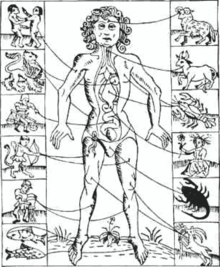Zodiac Man


The Zodiac Man dates all the way back to the Middle Ages and the body was seen to be divided up into regions just as the earth was. The belief back then was that man was known as “a little world”, the term they used to refer to this was ‘microcosm’, which is known to originate with the ancient Babylonians.
Astrological Medicine
The Zodiac Man was used in mainly in medicine by working alongside the moon. Wherever the moon and stars are aligned with a certain astrological sign they correlated with a body part, bodily system, or the four humors. The four humors separate the body into four parts just as there are four elements. The four humors of the human body are yellow bile, black bile, phlegm, and blood, it was believed that these all needed to be in balance in order to keep up with your health. These humors were used directly to treat illness alongside the Zodiac Man and were also used to explain and simplify concepts to patients. Europe was, at the time, required by law to calculate the moon’s positioning before taking action on a patient or any kind of medical procedure. If the moon was not in its correct positioning, nothing was able to be performed because it was deemed unsafe. They used a volvelle, a rotating calendar, to calculate the moon’s position as well as multiple almanacs which described different phases of the moon.
Most of the ways that illnesses were determined and diagnosed was through the four humors, especially through blood and yellow bile, better known as urine. This was one of the main ways people were diagnosed. Many pictures of the Zodiac Man solely depict the main body parts correlating with the astrological signs, but others go more in depth to then match the signs with internal bodily systems.
The Zodiac Man externally & internally:
Aries - Head, eyes, adrenals, blood pressure
Taurus - Neck, throat, shoulders, ears
Gemini - Lungs, nerves, arms, shoulders, fingers
Cancer - Chest wall, breasts, some body fluids
Leo - Heart, spine, upper back, spleen
Virgo - Abdomen, intestines, gallbladder, pancreas, liver
Libra - Lower back, buttocks, hips, kidneys, endocrines
Scorpio - Reproductive organs, pelvis, urinary bladder, rectum
Sagittarius - Thighs, legs
Capricorn - Knees, bones, skin
Aquarius - Ankles, blood vessels
Pisces - Feet, some body fluids
Over time leading into the Middle Ages, the belief of the Zodiac Man slowly faded out due to new scientific discoveries. While physicians, scientists, and doctors may have become wearier on the diagram and medical astrology, the people did not. The ordinary public stood by their belief of the signs the way they depicted the human body and its dependence of the moon.
History
The concept of the simplest form of the Zodiac Man can be dated back to originate with the ancient Babylonians, while the Mayans and Egyptians had analogues as well. Hebrew, Chinese, Vedic, and ancient Mithraic cultures also shared similar concepts of the man being seen as a microcosm. Besides medical purposes, the stars influenced many things in medieval history, such as agriculture, weather, even personality traits. It was no shock that the stars’ movements also helped in diagnosing illnesses or deciding when a medical procedure would be taking place. In the 12th and 13th centuries ancient astrological studies were translated from Arabic to Latin and soon enough even became required by law to calculate the moon’s position before performing any sort of medical procedure. It was in the second half of the 16th century when the belief in astrology in its medical form was at its peak in England to everyone including all of its society. Almanacs and many other print forms of astrology were in high demand at this time due to astrology’s sudden popularity. Most believed that knowledge of the moon and astrology was absolutely essential. Although the 17th century was the beginning of the very gradual downfall of scientific belief of the Zodiac Man, the idea of it was popular for very long after the Middle Ages.
Religion
The Zodiac Man is read and created off of the skies and their stars, or most commonly labeled as the moving ‘heavenly bodies’. This suggests a clear pathway to a religious aspect in zodiacal readings. Astrology was united with Christianity during the medieval period and medicine also tended to work hand in hand with the Christian church at the time. The signs of the zodiac are considered very spiritual but of course not only associated with Christianity, they are also associated with countless other religions as well including Islam and Judaism.
Related Figures
[1] Besides the Zodiac Man, other human figures and diagrams are also well known and were used in ancient time. There is the Vein Man, The Woman, The Wound Man, The Disease Man, and the Skeleton. These figures are all using different models and although it is difficult to say if there is any direct relationship between all of these, they are all focused on the human body, which is a large factor in the Zodiac Man’s history. There are other figures among them as well, but these are all most similar to the Zodiac Man. There are also several different Zodiac Man adaptations made such as Dutch, German, and also Venetian.
See also
- Medical astrology
- Vesalius
- Babylonian Astrology
- Medieval medicine of Western Europe
- Astrology
- Astrological Sign
References
- ↑ Coppens, Christian. “‘For the Benefit of Ordinary People’: The Dutch Translation of the Fasciculus Medicinae, Antwerp 1512.” Quaerendo 39.2 (2009): 168–205. EBSCOhost. Web. 14 Sept. 2014.
External links
| Wikimedia Commons has media related to Homo signorum. |